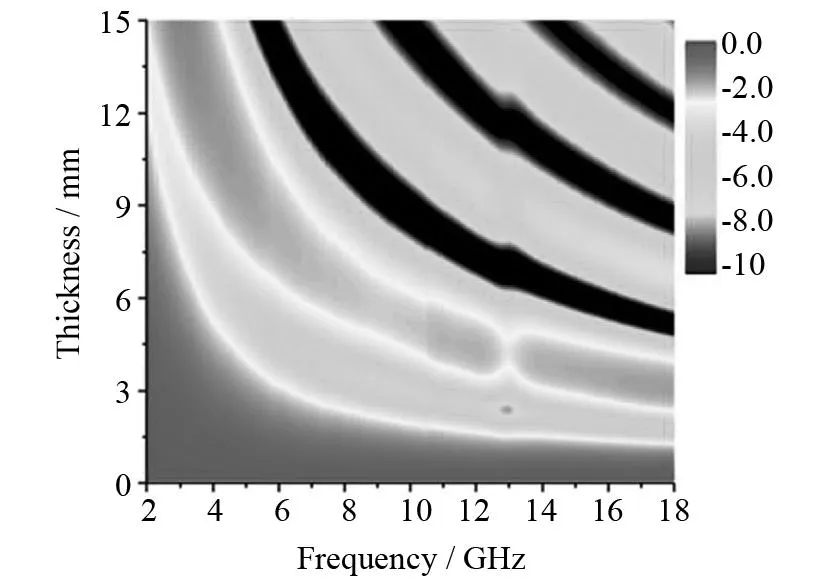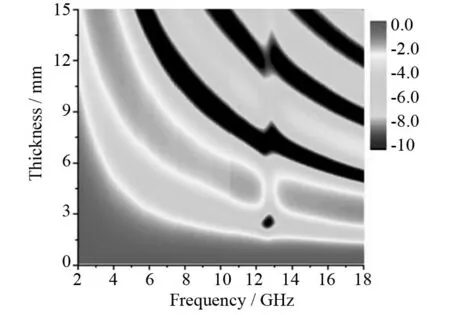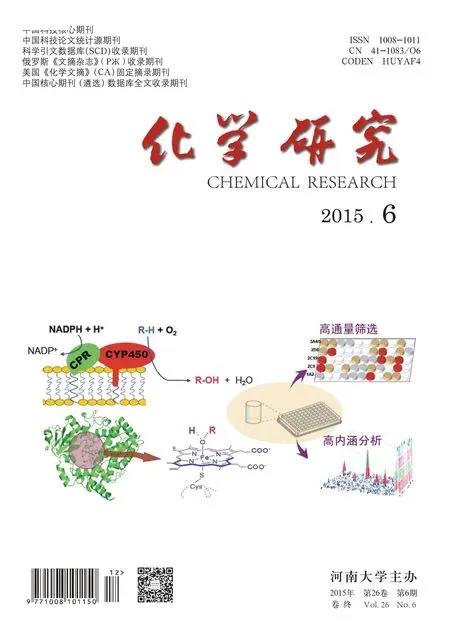一维钴纳米材料的简单制备及其磁性和电磁性能研究
2016-01-31孟红杰赵晓伟余来贵贾勇帅刘浩杰吕晓燕龚春红
孟红杰, 于 萍, 赵晓伟, 余来贵, 贾勇帅, 刘浩杰, 吕晓燕, 龚春红*
(1. 河南大学 化学化工学院,河南 开封 475004; 2. 河南大学 纳米材料工程研究中心,河南 开封 475004;
3. 河南大学 物理与电子学院,光伏材料省重点实验室,河南 开封 475004)
一维钴纳米材料的简单制备及其磁性和电磁性能研究
孟红杰1, 2, 于萍3, 赵晓伟1, 余来贵2, 贾勇帅2, 刘浩杰1, 吕晓燕2, 龚春红1*
(1. 河南大学 化学化工学院,河南 开封 475004;2. 河南大学 纳米材料工程研究中心,河南 开封 475004;
3. 河南大学 物理与电子学院,光伏材料省重点实验室,河南 开封 475004)
摘要:在常压下采用简单的液相还原法制备了一维钴纳米材料,并对比了一维纳米材料在研磨前后的形貌变化。结果表明,外加磁场的存在更利于钴纳米晶体的取向生长,得到的一维钴纳米材料在被充分研磨后仍然保持有较大的长径比,并且具有更好的电磁吸波性能.
关键词:钴;磁性材料;晶体生长;外加磁场; 电磁性能
Received date:2015-04-30.
Foundation item:The Natural Science Foundation of China (50902045).
Biography:MENG Hongjie (1990-), female, postgraduate, majoring in nano-composite absorbing materials.*Corresponding author, E-mail: gong@henu.edu.cn.
In recent years, morphological control of metals has become a subject of intensive research due to its importance in fundamental scientific research and potential technological applications[1-2]. Numerous reports have focused on the controllable preparation of ferromagnetic nanomaterials with one-dimensional (1D) assembled structures, because of their distinctive effect on common nanoparticles and high magnetic anisotropy[3-4]. Moreover, the well defined shapes make it possible for the magnetic materials to control the microwave absorbing properties. For example, the anisotropic magnetic particles can be used as the ideal material for electromagnetic wave absorption in a relatively high frequency range because of their higher resonance frequency which exceeds the Snoek’s limit in the gigahertz frequency range owing to their large shape anisotropy[5].
As typical magnetic materials, Co materials are promising electromagnetic wave absorbing materials in high temperature environment due to their higher Curie temperature (1 130 ℃) than Ni (353-360 ℃) and Fe (770 ℃)[6-8]. Unfortunately, very few investigations are currently available about the relation between the microstructures and the properties of 1D cobalt nanocrystals as candidates of microwave absorbers, though various methods such as electro-deposition method[9], structure-directing template-assisted method[10], and magnetic-field-induced growth route[11]have been developed for the synthesis of 1D cobalt nanocrystals. Furthermore, it should also be noted that a disperse treatment is usually needed to realize the measurement and applications[12], which induces the decrease in the length of 1D nanostructures after being treated under the shear stress generated in dispersion process[13]. However, the change of morphology after the grinding of the 1D nanostructure is often ignored[14].
In the present research, 1D Co nanostructures were prepared facially under both external magnetic field and self-generated magnetic field at ambient condition. Our results indicated that the Co nanostructure obtained under external magnetic field retained a large aspect ratio after being fully ground and exhibits a better microwave absorption performance than that obtained without external magnetic field. The reason might be ascribed to the better anisotropy and electromagnetic matching between dielectric loss and magnetic loss. This study is hoped to contribute to acquire more insights into the crystal growth and morphology-dependent electromagnetic absorption properties of magnetic materials.
1Experimental
1.1 Preparation of one-dimensional cobalt nanostructures
All the reagents are of analytical grade (Tianjin Kermel Chemical Company Ltd., Tianjin, China) and were used as received. Briefly, 0.6 g CoCl2·6H2O, 50 mL 1, 2-propylene glycol, 0.75 g of NaOH, and 3 mL of N2H4·H2O (80%, mass fraction) were uniformly mixed in a 250 mL beaker and then a 0.5 T NdFeB magnet was placed under the bottom of the beaker under the external magnetic field and the resultant mixture was heated to 60 ℃ and held there for 1-2 h. The resultant products were fully washed with ethanol, followed by drying in vacuum to afford anticipated Co nanostructure denoted as S2. Another Co nanostructure denoted as S1 was also prepared in the same manners for comparative studies while no external magnetic field was applied.
1.2 Characterization
The phase microstructures and compositions were analyzed by means of scanning electron microscope (SEM, JSM-5600LV; JEOL) and X-ray diffraction (XRD;λ= 0.154 18 nm). Magnetic measurements were conducted with a vibrating sample magnetometer (VSM, Lake Shore 7400). For the measurement of electromagnetic properties, as-synthesized Co nanostructures were mechanically mixed with the same weight of paraffin and pressed into cylindrically shaped compacts[15]; and then the complex permittivity and permeability were recorded at 2.0-18.0 GHz with an Agilent N5230A network analyzer.
2Results and discussion
2.1 Structure and morphology analyses of cobalt nanostructures
Fig.1a shows the XRD patterns of Co nanostructures of S1 and S2. It can be seen that both S1 and S2 exhibit four characteristic peaks at 2θ= 41.68, 44.46, 47.36 and 75.93°, being ascribed to the hexagonal-phase Co (JCPDS 05-0727)[16]. Evidently, the externally applied magnetic field has no effect on the composition and crystal structure of Co nanostructures. Moreover, the relative intensity of (002) peak of S2 is much higher than that of S1, indicating that the externally applied magnetic field promotes the preferred growth of Co nanostructure along the [001] direction[17].
Fig.1(b and c) shows the SEM images of as-prepared S1 and S2 and the same products after grinding. All Co nanostructures were found to exhibit chain-like morphology and have a length of about 10 μm whether in the absence or presence of external magnetic field. The as-prepared S1 and S2 were grinded in an agate mortar to examine the effect of the grinding on their morphology. It was found that although grinding led to the decrease in the length of the Co chains, S2 retained a large aspect ratio after being fully ground. This demonstrates that, under the applied magnetic field, Co particles tend to grow together rather than merely aggregate one another, owing to the enhanced nucleation and growth of Co nanocrystallite along the direction of the applied magnetic force. Different from S2, the chain-like S1 is almost fully broken into particles after grinding. This implies that the self-generated magnetic field, with a weaker intensity than that of the external one, can only induce weaker preferred orientation of Co crystalline.
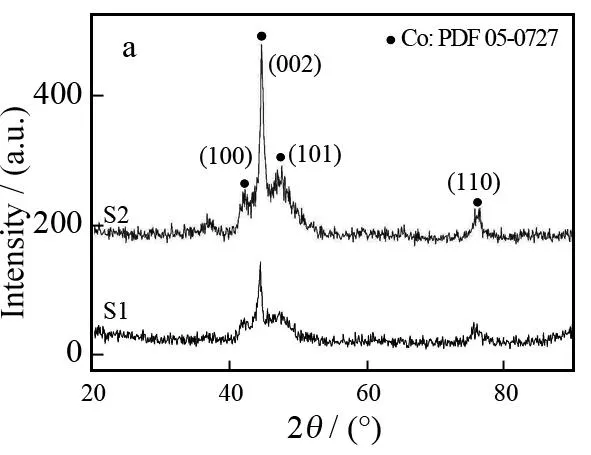
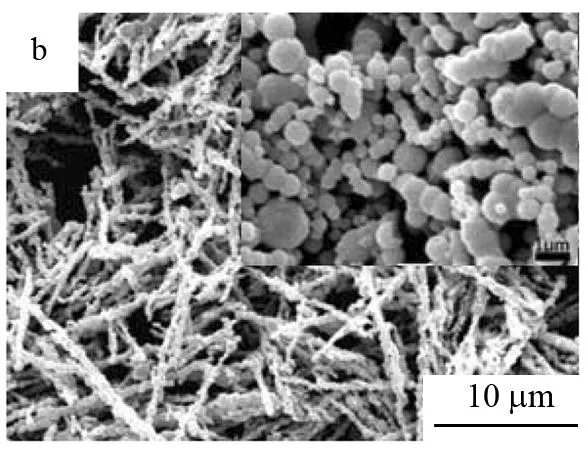
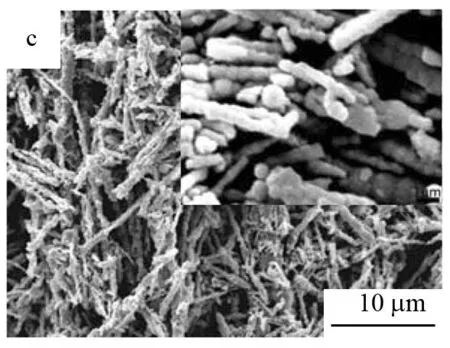
Fig.1 XRD patterns of sample S1 and S2 (a); SEM images of S1 (b) and S2 (c),
2.2 Magnetic properties
Fig.2 shows the room temperature hysteresis loops of S1 and S2 in the frequency range of -5 kOe Fig.2 Hysteresis loops of S1 and S2 in a frequency range of -5 kOe < H < 5 kOe at 298 K The microwave absorbing properties of materials are mainly dictated by their relative permittivity (εr=εr′ +iεr″) and permeability (μr=μr′ +iμr″). As illustrated in Fig.3, the dielectric loss (tanδE=εr″/εr′) and magnetic loss (tanδM=μr″/μr′) of the two Co-filled paraffin composites change with the variation of electromagnetic wave frequency in very similar manners, which should be attributed to the intrinsic nature of the fillers. Besides, in the frequency range of 11.5-13.2 GHz, S2-paraffin composite has a higher dielectric loss than S1-paraffin composite. Thus it can be inferred that S2-paraffin composite exhibits a lower electric resistivity than S1-paraffin composite, givingεr″ ≈ 1/2πε0ρf(ρis the resistivity) according to the free electron theory. The reason might be that the chain-like S2 with a high aspect ratio tends to form conducting networks which promote the increase in conductivity and enhancement of space-charge polarization, allowing Co particles to have more chances to interact with electromagnetic waves and to provide enhanced dielectric loss. Different from the above mentioned, S1 has smaller aspect ratio than S2, and the magnetic particles of S1 can be more efficiently isolated by paraffin. As a result, Co magnetic particles in S1-paraffin composite can hardly form conducting network, for which a lower dielectric loss is obtained. Fig.3 Frequency dependence of tanδE (a) and tanδM (b) of S1-paraffin and S2-paraffin composites The microwave absorbance capacity of metal-backed slabs can be evaluated by reflection loss (RL, in dB; a low reflection loss corresponds to a high absorption).The directly-measured and calculatedRLvalues are usually in good agreement due to the same underlying physical origin. To investigate the potential application of as-fabricated Co nanostructures as microwave absorbers, we use transmit line theory to calculate the microwave absorption capability by measuring the values ofεr′,εr″,μr′ andμr″[20]. Fig.4 shows the two-dimensional (2D)RLplots of S1-paraffin and S2-paraffin composites as the functions of the electromagnetic wave frequency and the thickness of absorber layer. As being expected, S1-paraffin and S2-paraffin composites exhibit very similar microwave absorbing properties, with S2-paraffin composite of a small absorber thickness (< 3 mm) possessing better microwave absorption capability at 13 GHz than S1-paraffin composite. This difference could be attributed to the different electromagnetic matching for the different morphology of S1 and S2. Fig.4 2D plots showing frequency dependence of the RL of S1-paraffin composite (a) and S2-paraffin composite (b) 3Conclusions To sum up, we have prepared 1D Co microstructuresviafacile liquid-phase reduction under normal pressure. The externally applied magnetic field promotes the preferred orientation of Co nanostructures, endowing Co nanocrystal large aspect ratios. The chain-like Co nanostructure obtained in the presence of external magnetic field, S2, possesses better absorption performance than that obtained without external magnetic field S1, probably due to the enhanced dielectric loss and the proper matching between the dielectric loss and magnetic loss of S2. We hope the present work can shed light on the growth and self-assembly mechanisms of 1D Co nanostructures, and further to promote their applications in electromagnetic wave absorption field. References: [1] 龚春红, 刘世江, 闫超, 等. 片状镍粉的制备及其磁性研究[J]. 化学研究, 2011, 22: 21-24. [2] GONG C H, DU C Q, ZHANG Y, et al. Morphology-controlled synthesis of nickel nanostructures under magnetic fields [J]. Chinese J Inorg Chem, 2009, 25(9): 1569-1574. [3] ZHAO B, FAN B B, SHAO G, et al. Investigation on the electromagnetic wave absorption properties of Ni chains synthesized by a facile solvothermal method [J]. Appl Surf Sci, 2014, 307: 293-300. [4] FU M, JIAO Q Z, ZHAO Y. In situ fabrication and characterization of cobalt ferrite nanorods/rapheme composites [J]. Mater Charact, 2013, 86: 303-315. [5] MA F, QIN Y, LI Y Z. Enhanced microwave performance of cobalt nanoflakes with strong shape anisotropy [J]. Appl Phys Lett, 2010, 96: 202507. [6] COLVIN R, ARAJS S. Magnetic susceptibility of face-centered cubic cobalt just above the ferromagnetic Curie temperature [J]. J Phys Chem Solids, 1965, 26: 435-437. [7] LEGENDRE B, SGHAIER M. Curie temperature of nickel [J]. J Therm Anal Calorim, 2011, 105: 141-143. [8] MA E, ATZMON M, PINKERTON F. Thermodynamic and magnetic properties of metastable FexCu(100-x)solid solutions formed by mechanical alloying [J]. J Appl Phys, 1993, 74: 955-962. [9] CHEN W B, HAN M G, DENG L J. High frequency microwave absorbing properties of cobalt nanowires with transverse magnetocrystalline anisotropy [J]. Phys Rev B: Condens Matter, 2010, 405: 1484-1488. [10] EL-SHEIKH S, HARRAZ F, HESSIEN M. Magnetic behavior of cobalt ferrite nanowires prepared by template-assisted technique [J]. Mater Chem Phys, 2010, 123: 254-259. [11] ATHANASSIOU E, GROSSMANN P, GRASS R, et al. Template free, large scale synthesis of cobalt nanowires using magnetic fields for alignment [J]. Nanotechnology, 2007, 18: 165606. [12] ZHANG X F, DONG X L, HUANG H, et al. Microstructure and microwave absorption properties of carbon-coated iron nanocapsules [J]. J Phys D: Appl Phys, 2007, 40: 5383-5387. [13] XU G H, ZHANG Q, HUANG J Q, et al. A two-step shearing strategy to disperse long carbon nanotubes from vertically aligned multiwalled carbon nanotube arrays for transparent conductive films [J]. Langmuir, 2009, 26: 2798-1804. [14] GONG C H, ZHANG Y, YAN C, et al. Electromagnetic shielding behavior of composites containing ultrafine Ni fibers [J]. Rare Metal Mat Eng, 2010, 39: 1298-1301. [15] ZHANG D F, XU F X, LIN J, et al. Electromagnetic characteristics and microwave absorption properties of carbon-encapsulated cobalt nanoparticles in 2-18 GHz frequency range [J]. Carbon, 2014, 80: 103-111. [16] YAN S J, DAI S L, DING H Y, et al. Influence of Ni/Co molar ratio on electromagnetic properties and microwave absorption performances for Ni/Co paraffin composites [J]. J Magn Magn Mater, 2014, 358: 170-176. [17] WANG C, HAN X J, ZHANG X L, et al. Controlled synthesis and morphology-dependent electromagnetic properties of hierarchical cobalt assemblies [J]. J Phys Chem C, 2010, 114: 14826-14830. [18] GONG C H, TIAN J T, WU Z S, et al. Effect of external magnetic field on magnetic properties and electromagnetic shielding performance of ultrafine nickel particles [J]. Chinese J Inorg Chem, 2008, 24(6): 964-970. [19] LUO J H, GAO D D. Synthesis and microwave absorption properties of Ppy/Co nanocomposites [J]. J Magn Magn Mater, 2014, 368: 82-86. [20] 龚春红, 贺洁, 张玉, 等. 片状镍粉填充树脂基和石蜡基复合材料的微波电磁特性[J]. 化学研究, 2010, 21: 27-31. [责任编辑:毛立群]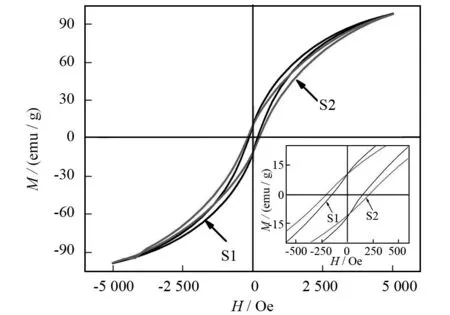
2.3 Electromagnetic properties
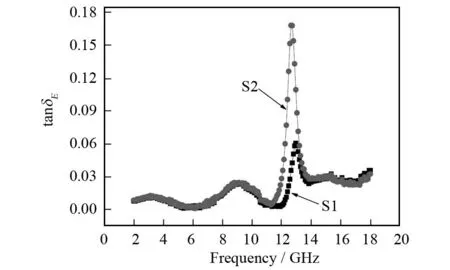

2.4 Microwave absorbing properties
